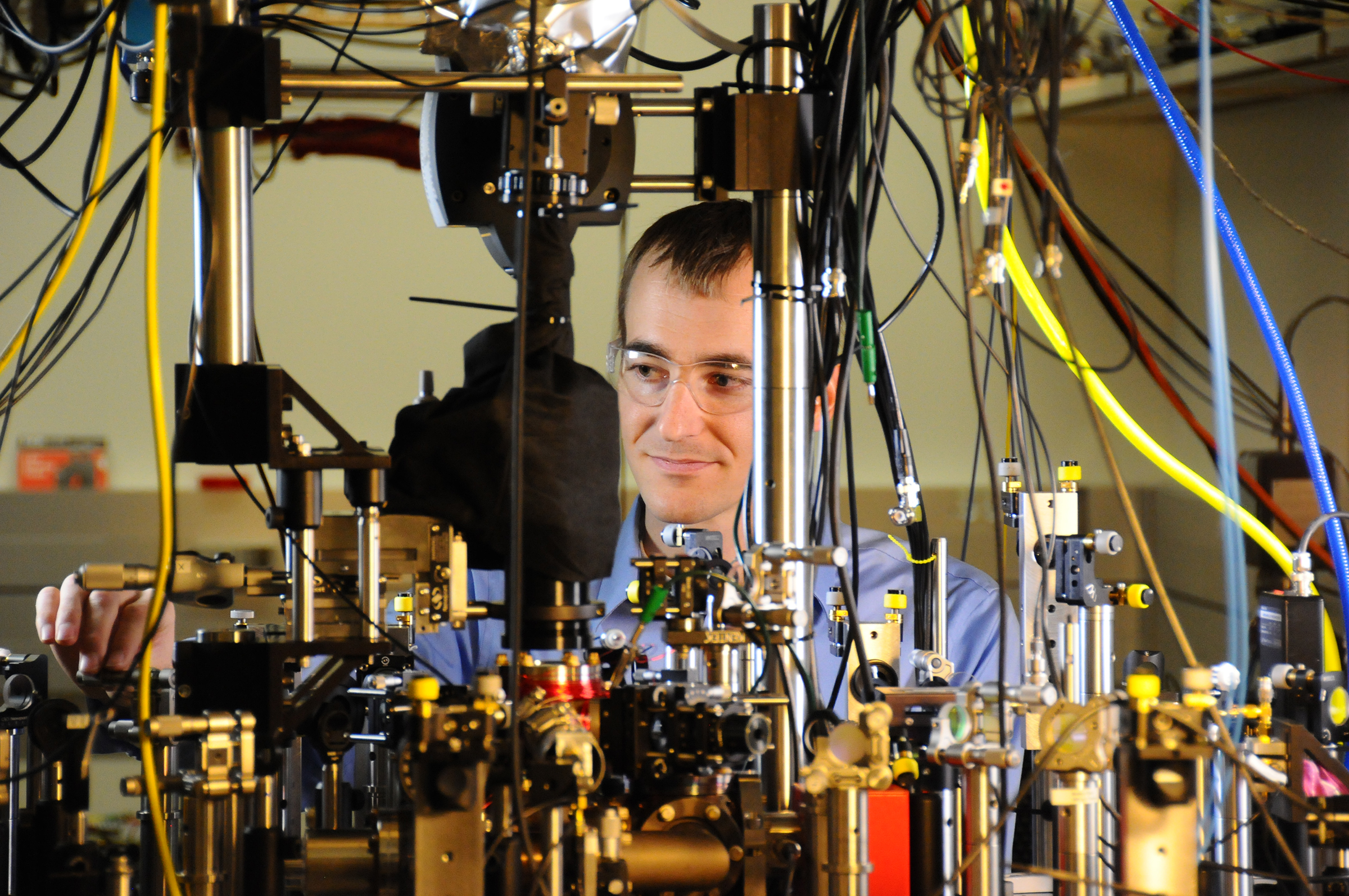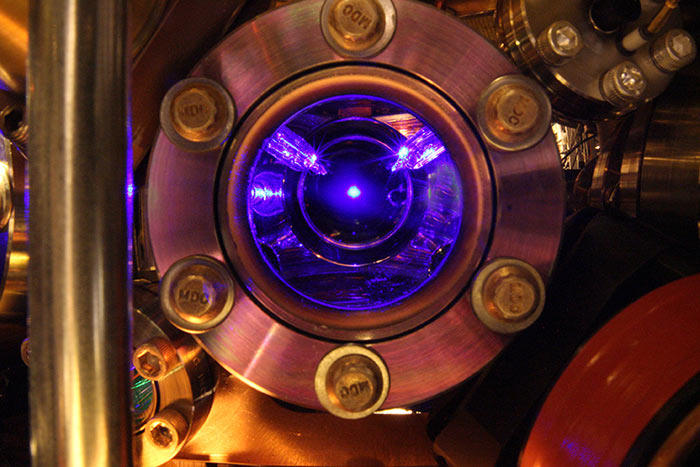Optical Clocks: The Future of Time

Clock makers are never satisfied. Now that the hyper-accurate seconds produced by cesium clocks have become routine, even steadier and more precise ticks of time beckon.
To beat cesium, we must pluck the notes of atoms with much higher natural resonant frequencies — frequencies of light that are visible to the human eye. The optical clock has emerged as the upstart of the timekeeping world. It has toppled long-standing accuracy and stability records and is now poised to redefine the world’s seconds for the first time in more than 50 years.
A Daunting Challenge
The microwaves that power beam clocks and fountain clocks oscillate nearly 10 billion times per second. That sounds fast — it’s certainly much faster than we can count.
But visible light waves make microwaves look as pokey as a bicycle trying to keep up with a race car. A visible light wave can pack 100,000 times more oscillations into a second, dividing the second far more finely. Just as a meter stick with ultrafine tick marks allows you to measure tiny objects, the more you divide your second, the more accurately you can measure time.
To make optical clocks a reality, scientists had to overcome several challenges. First, they needed to find atoms with resonant frequencies in the optical range. Early optical clocks used hydrogen, calcium and mercury atoms, but over time, aluminum, strontium and ytterbium have emerged as the top performers.
A Finer Ruler

The electromagnetic waves used in atomic clocks have frequencies that fall either in the microwave region or in or near the visible region, which makes up a small but very important part of the overall spectrum. Note that certain atoms or ions, such as rubidium and ytterbium, have multiple resonant frequencies that can be used for clocks. Click here for more detail on atomic frequencies used for clocks.
A “nuclear clock” based on an energy transition in the nucleus of the thorium atom would use a frequency of light in the ultraviolet part of the spectrum. So far, no one has made a nuclear clock, but scientists are working toward this next leap in atomic clock technology.
Scientists also had to improve the lasers they used to probe atoms. Lasers emit narrow beams of single-color, coherent light (meaning the peaks and valleys of neighboring light waves line up), unlike the multicolored, incoherent light that comes from, say, a light bulb or the Sun. Since being invented in the 1950s, lasers have become commonplace. You’ve probably used them to scan groceries, amuse cats and do many other things. But not all lasers are created equal, and the ones used in daily life are far too imprecise for an atomic clock.
To manipulate and probe the inner workings of atoms, physicists needed extremely stable laser light with a narrow range of unvarying frequencies. Optical clock lasers are typically stabilized using an optical cavity — a finely machined chamber of glass where light bounces back and forth between mirrors millions of times to build up a nontraveling wave with a precise frequency.
Even ultra-stable lasers locked to pristine optical cavities and tuned to atoms with large resonant frequencies weren’t enough to make an optical clock. Scientists also needed a way to count the wave peaks of that laser light with extreme accuracy — something beyond the reach of conventional electronics. The breakthrough came in 1999, when physicists invented the frequency comb. Frequency combs are essentially rulers for light that can translate visible light frequencies into microwaves that electronics can read.
Within a few years, scientists had used the frequency comb to make an optical clock that was more accurate than any existing clock. The best of these clocks are now 100 times more accurate and stable than cesium fountain clocks. And they are still improving, as physicists build better lasers and find ways to super-cool clock components and package them in tighter vacuum chambers, minimizing vibrations and unwanted collisions with air particles.
Now that optical clocks reliably outperform microwave clocks, the world’s timekeepers are preparing to redefine the second based on an optical standard — the first redefinition of the fundamental unit of time in more than 50 years.
Optical clocks are also helping physicists do new kinds of experiments, pushing into previously inaccessible realms. Optical clocks have ruled out certain possibilities for dark matter, put new constraints on theories that certain fundamental constants could be changing over time, and tested Einstein’s theory of gravity in bold new ways.
Optical clocks come in two main flavors that work very differently from each other.
Trapped Ion Clocks: Cages of Energy
Trapped ion clocks tune a laser to the resonant frequency of a solitary atom, making them perhaps the purest realization of the atomic clock.
This clock starts with an ion — an atom that has one or more of its electrons removed or added, so it becomes electrically charged. This electric charge means the ion can be pushed, pulled and ultimately trapped using electric and magnetic fields. Scientists use an oscillating electromagnetic field to confine the ion to the bottom of an energy well, like a marble brought to rest in a bowl. Once the ion is caught in this electromagnetic grip, scientists tweak and probe it with lasers.
One of the world’s best trapped-ion clocks is based on an aluminum atom with one electron removed to make it positively charged. When scientists put an aluminum ion into its higher-energy state, it stays there for a long time, making it a good ion to tune a laser to. Trapped aluminum ions are also exceptionally resistant to thermal noise.
To run the clock, scientists first trap and cool an ion, then bathe it in laser light and measure whether it has absorbed any of the light and jumped to the higher energy state. A typical laser bath lasts about a second. By immersing the atom over and over in slightly different colors of light, scientists build up data that helps them tune the clock’s laser frequency closer and closer to the aluminum resonant frequency.

Physicists have also made trapped-ion clocks using ytterbium, a much heavier metal. This ion has two different resonant frequencies that can both be used for clocks, allowing the clock’s performance to be measured against itself.
Because trapped ions are well protected from frequency shifts caused by the external environment, they can produce some of the world’s most accurate ticks of time. The best of these clocks are so good that if they had run continuously since the Big Bang, they would have gained or lost less than a second. (So far, however, they have run for only a few days at a time.)
But another kind of optical clock has proved to be even more stable.
Optical Lattice Clocks: Clocks Built on ‘Magic’
Instead of making exquisite measurements of just one atom, optical lattice clocks tune to the oscillations of thousands of atoms at once.
In a lattice clock, overlapping laser beams construct an energy landscape of peaks and valleys. This web of light creates a sort of electromagnetic egg carton with individual atoms resting in some of the egg compartments. Depending on the number of laser beams, the lattice compartments can be arranged in a one-dimensional line, a two-dimensional plane or a three-dimensional box.
Like an ion trap, the lattice lasers stop atoms cold so their internal oscillations can be measured for a long time. Because they also allow scientists to average measurements over all of the atoms at once, lattice clocks have become the most precise and stable clocks in existence.
A funny thing about lattice clocks is that they shouldn’t even work. Quantum physics tells us that the trapping lasers’ powerful electromagnetic fields should strongly shift the trapped atoms’ resonant frequencies, making them useless as clocks. But a surprising phenomenon makes the lattice clock possible after all: the so-called magic wavelength.
In the early 2000s, physicists discovered that laser light of certain wavelengths (the wavelength and frequency of light are inversely related) can pull on the atoms in counteracting ways that almost exactly cancel out, leaving their resonant frequencies unchanged.
Is the magic wavelength truly magic? Maybe not, but it’s certainly a beautiful — and useful — surprise hidden within quantum physics.
Since the lattice clock was invented, scientists in several countries have built versions based on different atoms. Strontium and ytterbium are currently among the most popular.
Similar to their trapped-ion cousins, the lasers and electronics needed for lattice clocks can take up several rooms. They are complicated and finicky devices. One or more scientists usually needs to be there to turn knobs and tweak dials.
But these clocks have lately been making their way out of the lab. Portable, dishwasher-sized lattice clocks have summited skyscrapers and crossed the country on road trips. NIST scientists will soon take one up a 14,271-foot (4,350-meter) Colorado mountain to attempt a bold new test of Einstein’s theory of general relativity.
And companies are selling the first commercial optical clocks, using a simpler design based on iodine molecules. These clocks aren’t record breakers, but they are cheaper and easier to build. Iodine clocks will be on board the European Kepler navigation satellites, and one may soon join the ensemble of clocks NIST uses to produce official U.S. time.
The future of optical clocks is looking — no pun intended — bright.


